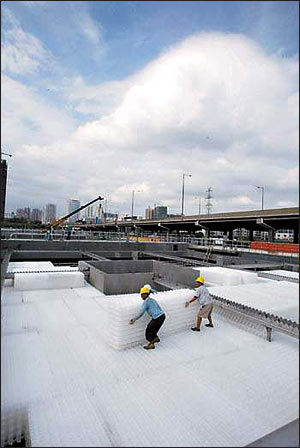Environmental quality has seen great improvement thanks to years
of sustained pollution control. In 2005, 65.8 percent of cities
recording air quality reached the national air quality standard of
Grade II; up-to-standard potable water was 96.8 percent; urban
sewage daily disposal capacity reached 80.91 million cubic meters,
9.5 percent up on the previous year; the rate for hazard-free
treatment of urban household waste was 57.8 percent and for
comprehensive utilization of solid industrial waste, 55.7 percent.
By the end of 2005, the total discharge amount of the main
pollutants was 10 percent down than in 2000, and of these S02
emissions fell by 20 percent. In most areas pollution has eased,
the environmental quality of key cities and areas improved and
trend of ecological deterioration curbed.
 |
To tackle a new and increasing pollution problem the government
drew up an electronic waste management system that extends producer
responsibility and requires the producer to take partial or full
responsibility for the environment where the electronic waste is
abandoned. The system is designed to encourage greater
consideration of the environment and use of recyclable materials on
the part of producers. At the beginning of 2004, Zhejiang Province
and Qingdao city were designated experimental sites for
construction of disposal and recycling system for waste household
electrical appliances and electronic products.
Since 2003, the State Environmental Protection Administration
has published annual updates on pollution control in national key
river basins and sea areas. Since the Yangtze Three Gorges Dam
started to impound water on June 10, 2003, water quality in the
reservoir area has not changed much from before. To ensure a safe
water environment in the Three Gorges Reservoir Area, the
government has planned to invest about 40 billion yuan between 2001
and 2010 to control water pollution in the reservoir area itself
and the upper Yangtze. According to the Plan for Control of Water
Pollution in Three Gorges Reservoir Area and the Upper Reaches of
the Yangtze River, by 2010, water quality at the main control
sections in the reservoir area and upper reaches of the river
should meet Grade II standard as stipulated in the Environmental
Quality Standard for Surface Water, and the eco-environment in the
reservoir area should be much improved.
The seriously polluted Taihu Lake Basin started to receive a
special "transfusion" treatment from 2002 -- clean river water was
transported from the Yangtze into this freshwater lake basin
covering an area of 36,900 sq km. Since its inception, the project
has improved the water environment of the Taihu Lake Basin,
benefiting a population of nearly 10 million.
For five consecutive years from 2001 to 2005, the Yellow River
has not run dry and for three years running emergency water
transfer from the Tarim River to the lower reaches has greatly
improved the downstream eco-environment.
The program for prevention and control of water pollution, which
started in 2001, planned five years of projects in 1,534 cities
involving investment of 103.63 billion yuan. These included schemes
for sewage treatment, water pollution prevention and control,
control of agricultural and rural pollution, and comprehensive
control of drainage areas. The vast majority of the projects have
been completed and put into operation.
(China.org.cn)